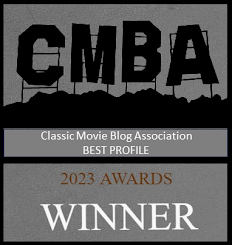During the Christmas holidays, I found a list of my favorite movies, which I'd compiled many years ago. To my surprise, about 70% of the films were still ones I enjoy watching every year or two. I thought it might be amusing to revise my list and do a monthly series of posts where I count down my faves from #100 to #1. Several of the films are ones I've reviewed at the Cafe, while others are pretty obscure.
My film tastes are pretty eclectic, so my favorites feature performers as diverse as Errol Flynn, Spencer Tracy, Deborah Kerr, Hayley Mills, and Bruce Lee (in fact, I list at least two films by each of those stars). There are Hammer films, foreign-language films, Disney, and Hitchcock. And there are robots, gargoyles, soldier ants, and even "humanimals." Let me stress that these are not what I consider the greatest films ever made (though some of them are). Rather, they are just one film buff's favorites.
Sadly, there were a handful of movies that just missed out on a place on the list. These honorable mentions include Trinity Is Still My Name, Young and Innocent, The Flim Flam Man, Body Heat, The Fury, Cornered, The Five Man Army, Repeat Performance, Star Trek II: The Wrath of Khan, and Random Harvest. And now, it's my proud pleasure to count down 100-91:
100. Ten Little Indians (1965)/John Carpenter’s The Thing - I know, I've already cheated by starting with a tie so I could squeeze in 101 favorite films. But the truth is that these two films both feature a setting and premise that have always appealed to me: an isolated snowy location and a murderer that could be anyone. I know plenty of movie lovers are aghast that I didn't pick the more renowned And Then There Were None. However, it's not set on a snow-covered mountain...and doesn't have a "murder minute."
99. Rocky - The variable quality of the sequels doesn't diminish the original, which presents a gritty, winning underdog story. Whenever it's on TV (which is a lot), I find myself compelled to watch it from whatever point I join the plot.
 |
| Natalie Wood recites Wordsworth. |
97. My Cousin Rachel - Atmospheric adaptation of Daphne du Maurier's haunting novel stars Richard Burton as an intense young man who falls in love with his new aunt (Olivia de Havilland)--even though he suspects her of murdering his uncle. Set among the rocky beaches of Cornwall with its crashing waves (I strongly recommend watching it at the beach).
 |
| Diane Lane in Streets of Fire. |
95. Inherit the Wind - I love a good courtroom drama (there will be others on my list) and this is one of the best. The case, based on the "Scopes Monkey Trial" of 1925, certainly holds one's interest. However, what lingers are the brilliant performances of Spencer Tracy and Fredric March--plus the film's fascinating portrait of public opinion and the men that try to shape it.
94. The Best Man - Gore Vidal's sharply-observed look inside American politics stars Henry Fonda and Cliff Robertson as rivals fighting for their party's presidential nomination circa 1964. Both candidates harbor secrets that can destroy their political aspirations and their loved ones. This gripping drama features a stellar cast and a most satisfying and realistic conclusion.
 |
| Peggy Cummins as the carnival sharp- shooter with more ambitious plans. |
92. Greyfriars Bobby - This forgotten British Disney film may be the finest examination of the special bond between humans and dogs. The plot is based on the amazing true story of a loyal Skye Terrier who slept on his master’s grave in an Edinburgh cemetery every night for 14 years. The low-wattage cast, featuring Donald Crisp and Laurence Naismith, gives sincere performances and the heartfelt story never turns maudlin.
 |
| Scary-looking and hard to kill... because they're dead! |
Next month, I'll count down 90-81, which will include the first of multiple list appearances by Alfred Hitchcock and Hammer Films, plus the place I'd like to take my wife for a second honeymoon.

















































